Achraf Hakimi is on the verge of moving from his current club Real Madrid to Inter Milan. The Moroccan loaned by BVB have already given the Italian top club his promise for a transfer this summer. According to information from Sky Italia, the transfer is around 40 million euros.
Most recently, Borussia Dortmund also tried to keep their loaner. “We can imagine a stay of Hakimi at BVB,” said sports director Michael Zorc recently, but also referred to the right-back’s contract at Real Madrid. “We would like to see him with us for longer, that’s clear too. But we cannot influence it on our own”, said Zorc about the Hakimi personnel in the spring. “I believe that Achraf knows very well what development he has taken with us. He just took it from us, not anywhere else. ”
But now Inter have apparently won the transfer fight for Hakimi. Hakimi’s wish is to play regularly at a new club. At his former club Real Madrid, this would not be the case due to the competition from Dani Carvajal – but it would be the case with the current third in the Serie A table.
In this scout report, we take a closer look on Hakimi´s playing style. In the tactical analysis, we will also figure out how Hakimi will fit into Antonio Conte´s tactics at Inter.
Role in the system at BVB
Recently, head coach Lucien Favre lined up his team in a 3-4-3 formation in attack. This system provides a lot of flexibility as it changes into a 5-4-1 in defence. Crucial for that are the two wing-backs. While Raphaël Guerreiro is used to play this position on the left side on the pitch, Hakimi played on the right-wing at Dortmund. To no surprise, Favre has eventually deployed Hakimi in a more advanced role. Last season, Dortmund operated in a 4-2-3-1 system and used Hakimi primarily at left-back where it was quite obvious that he was a defensive liability.
In the picture below, you can see Dortmund´s 3-4-3 formation. This means, that in attack, Raphaël Guerreiro and Hakimi played as midfielders. Without possession, they changed into a more defensive role as full-backs within a back-five. Then, the two wingers (in this case Thorgan Hazard and Jadon Sancho) dropped into the midfield position.

In attack, the two wingers Hazard and Sancho drifted towards the centre of the pitch and therefore, they were positioned near their forward. At the same time, these movements opened up space for the wing-backs. That is why, Hakimi played a very offensive part in the Dortmund system under Favre during this campaign. As you can recognize in the following image of the realistic positioning, Dortmund played in a 3-2-5 shape with seven players within the opponents´ half when they were in possession.
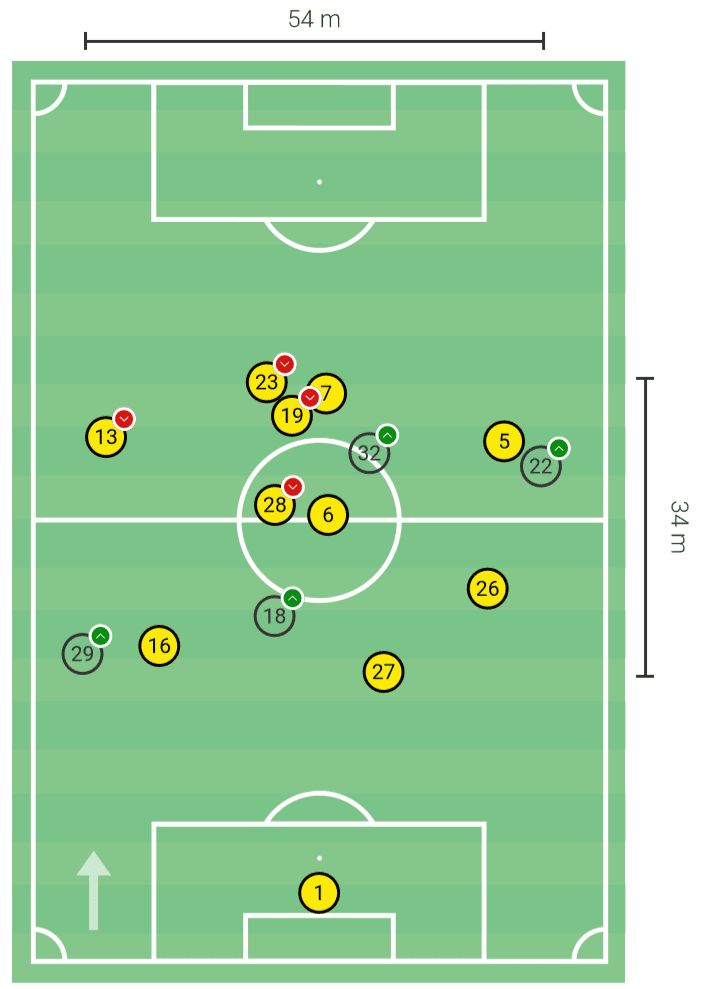
In the following map, it becomes obvious that most of the time, Dortmund attacked the right side of the pitch. Definitely, that is a proof for Hakimi´s offensive playing style as most chances were created on his wing. That is why, Dortmund will miss him next season and it does not make sense to let him go as they got a matching right and were always informed about an Inter offer so that they could make an offer as well. In this campaign, Hakimi played in 85% of all matches in all competitions and therefore, he was an irreplaceable starter for Favre.
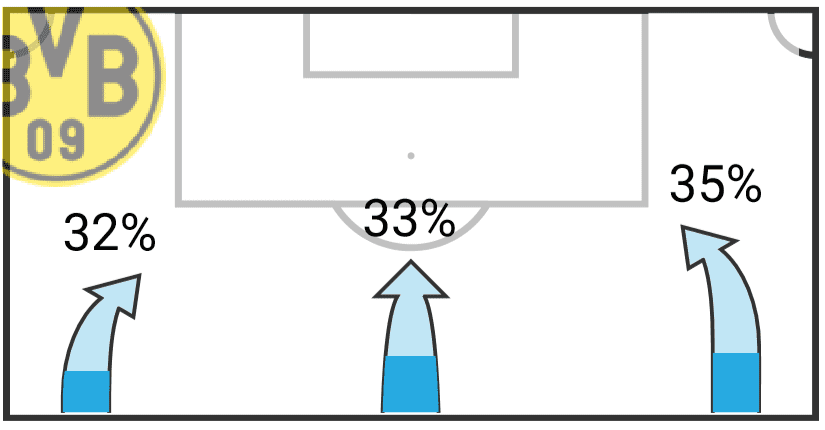
Role in the system at Inter
Like all teams of head coach Conte, Inter is well-known for their outstanding performances in the defence and therefore, known as one of the best defensive teams in the world. What makes the move to Inter so appealing is the fact that Conte also uses a system with wing-backs. Adding to that Inter play with a double-pivot and one central offensive midfielder. The two strikers complete the line-up. Again, the two wing-backs move between the backline and midfield line in transitions and therefore, play a very important role in Conte´s tactics. And, Hakimi is a perfect player for transitions. The outstanding attribute for Hakimi is his athleticism which is so noticeable that he is almost always the fastest player on the pitch. The 21-year old clocked a top speed of 36.2 km/h against RB Leipzig recently. His threat on the counter lured Favre to use him as a wing-back. Currently, Inter uses Antonio Candreva as the right wing-back, who is not as quick and agile or anywhere near the attacking threat in Hakimi. They improve their squad tremendously with the reception of a more prolific and frighteningly quick wing-back.

In the map with Inter´s realistic positioning, you can see that the three offensive players are not positioned next to each other in the centre but they are more spread. It is outstanding, that Inter´s wing-back Candreva is positioned high up the pitch as Hakimi is at Dortmund. Ashley Young on the left-wing plays more conservative and defensive. Hakimi, who can play on both wings, would simply slot straight in on one of the two wings. If Conte wants to play more offensive against, Hakimi could come in for Young on the left side. Then, Conte would have two offensive-minded wing-backs. If Conte wants to play more defensive, he will use Hakimi instead of Candreva to have also one conservative wing-back with a more defensive playing style on the pitch.

This season, Inter created most of their chances through the centre. One of the reasons for that might be a missing wing-back as Inter only have former wingers or full-backs in their squad. Adding to that, they bought creative playmaker Christian Eriksen for their central offensive midfield. Lautaro Martínez played more as a false 9 so that he initiated lots of attacks from the centre as well. With Hakimi on the wing, their playing style will get more flexible and more unpredictable. It will add more sharpness to Conte’s system, specifically in regards to progressing the ball, while they also over-relied on their midfield to create for their strikers.
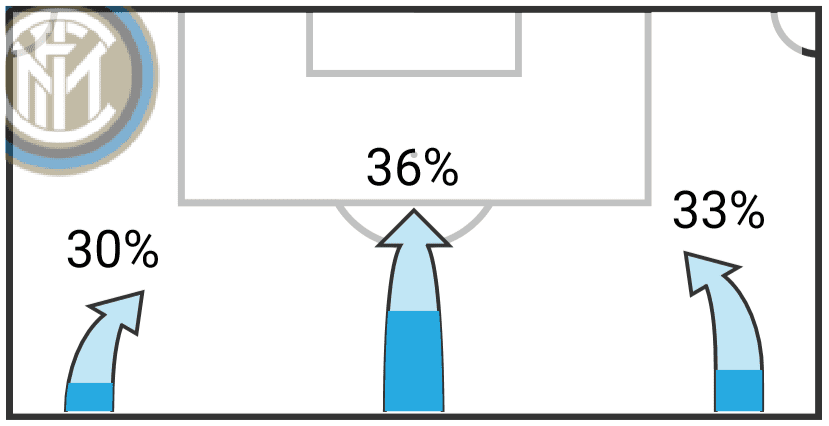
Off-the-ball movement
One of the most important aspects of wing-backs is their off-the-ball movements during the match. Hakimi is well-known for his overlapping runs. As mentioned earlier, Dortmund´s right-wing drifted into the centre to open up space for Hakimi. With Hakimi making an overlapping run, the player in possession has several passing options. Having Marcelo Brozović , Eriksen, and likely Sandro Tonali, Inter have an array of distribution options in their midfield to complement Hakimi’s use of pace whenever he gets in behind.
In the situation below, Hazard plays as a right-wing and is in possession. Looking for a passing option he drifts into a more central area. With Julian Brandt playing as striker and Hakimi as right wing-back, Hazard has now two passing options. Even if he plays to Brandt, Brandt has two options. He can turn and dribble into a more advanced area on the pitch or he can set up Hakimi on the right-wing who, then, can create a goal-scoring opportunity with a cross into the opponent´s box.

So, Hakimi is able to support the offence with his progressive runs. In the map below, you can see his progressive passes as well as his progressive runs. In average, Hakimi provides 3.54 progressive runs per 90 minutes which is the fourth-best result in the Bundesliga. Again, Hakimi´s pace helps him a lot in these situations.

By comparing Hakimi´s statistics with the ones of Inter´s current wing-backs we can see that he is by far the best concerning his progressive distance (599 meters per 90 minutes) as well as his successful dribblings (2,13 per 90 minutes). This means that he is definitely the most encouraged and technical gifted full-back from the list.
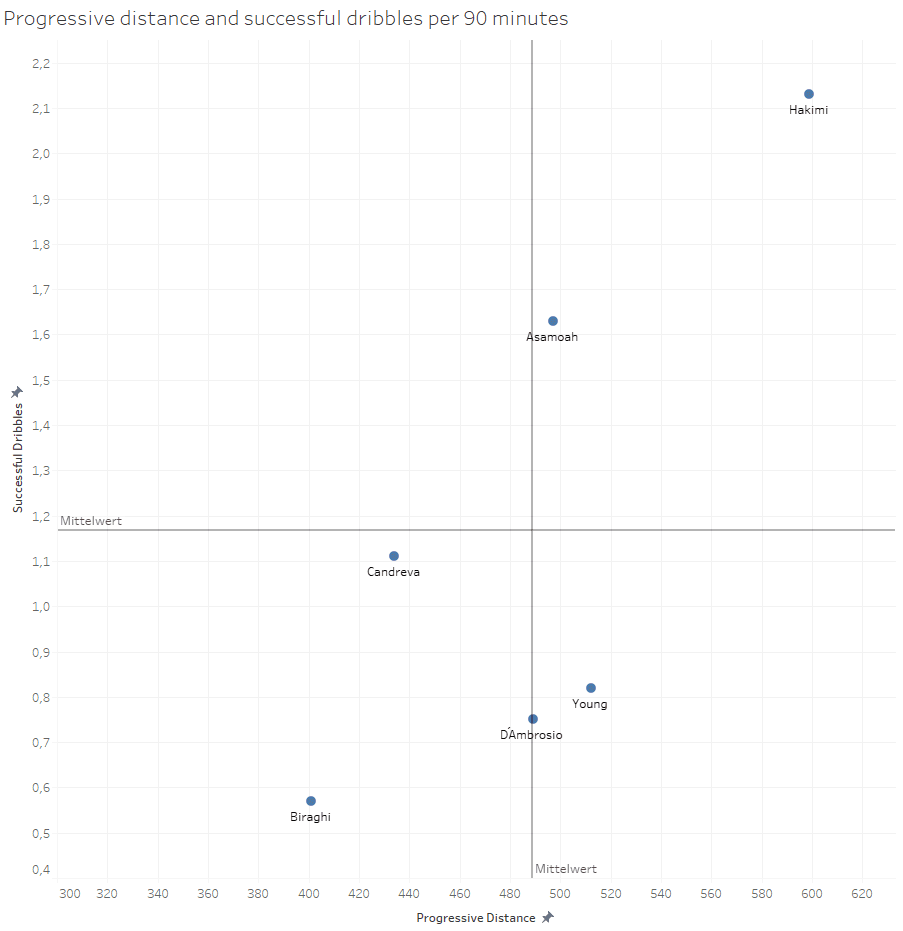
Chance creation
Hakimi’s pace is complemented with absurd acceleration. He hits top gear quickly which is advantageous in all areas of play. The effectiveness of his pace, however, is what’s earned him much acclaim. Watching Hakimi‘s movement, you are almost guaranteed to think he was once a striker. He applies his speed by having perfectly timed runs in behind providing a constant through ball threat for back lines. Hakimi is a rare weapon in counter-attacks in terms of assisting, as well as finishing for his position. His shooting technique allows him to finish from every angle and even his weak foot is not much of a weakness.
As you as can see here, Hakimi starts out wide and passes to Sancho, while making the perfect run through the defence. He finishes the ball with top composure and showcases his admirable off-the-ball movement once again.
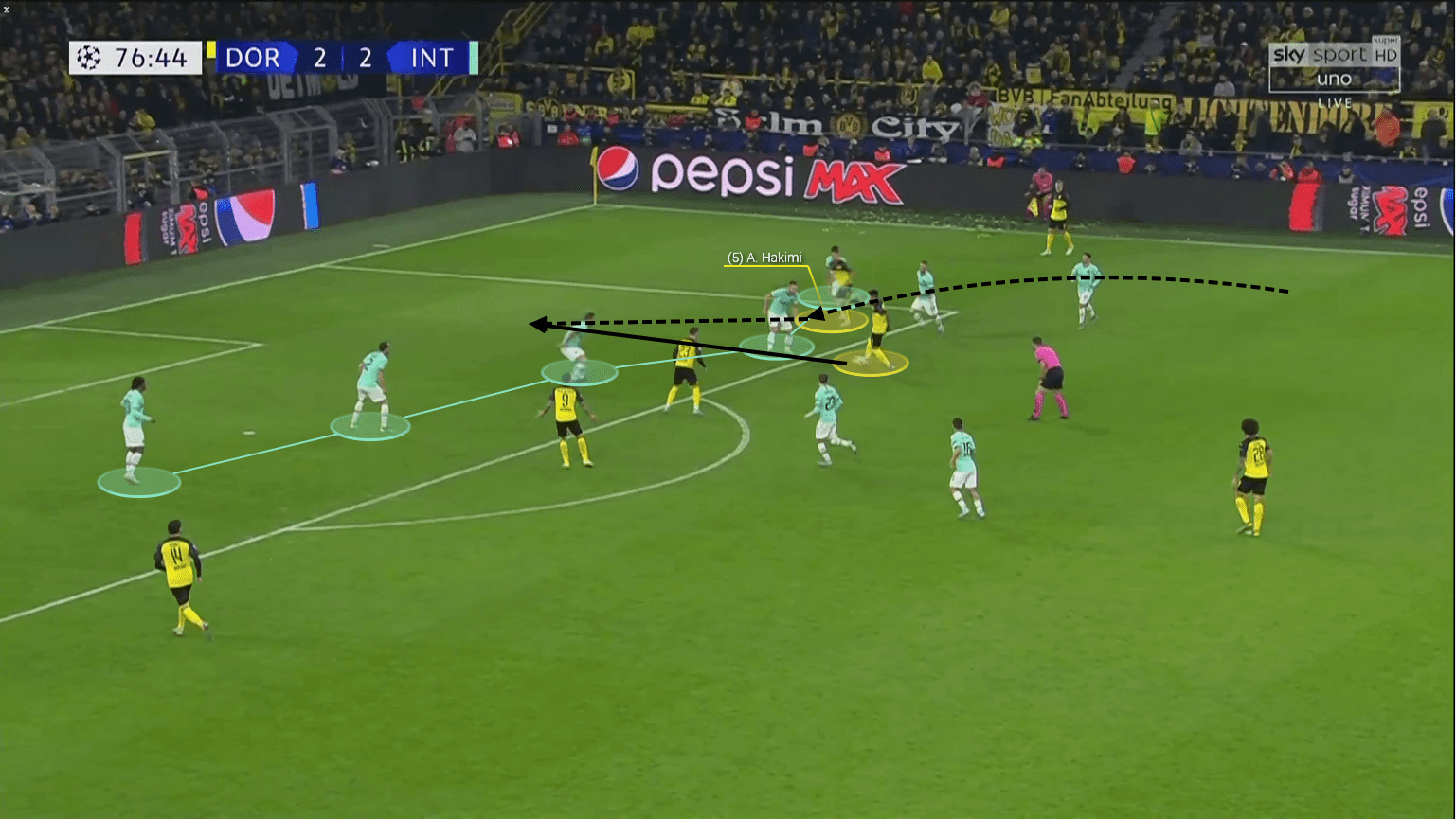
In terms of wing-play, Favre developed Hakimi into a superb assister. He is impressive at scanning the box and finding the open teammate for a cutback. His crosses are hit, more times than none, with perfect weight and timing, but his accuracy is sometimes a bit off.
By doing his typical movement, Hakimi runs to the byline and then, most of the time, plays a flat cross back into the penalty area. The image below is a great example for his movement and the following flat cross into the penalty area, where a teammate was positioned most of the time.

Another example: If Hakimi does not need to sprint to the byline, he drifts more centrally and plays a more vertical flat cross into the penalty area again. As Inter have a very good header with the likes of forward Romelu Lukaku, Hakimi will have to play more air crosses instead of flat ones.

At Dortmund, Hakimi took advantage of his chance creation very well. In the Bundesliga, he scored five times and assisted nine more times. In all competitions, he scored nine goals and made ten assists. These are 19 goal-contributions in 45 matches this season. And, as you can see in the list below, he overperformed his xG. He even assisted 4 more goals than expected.

At his former club Madrid, only Karim Benzema contributed more goals (24) this season. At Inter only the two forwards Martínez (23) and Lukaku (30) contributed more goals. With the pairing of Lukaku and Martínez, Hakimi will have active runners for his strikers, who are more than capable of supplying the right finish for his crosses. That is why it will be interesting to see, how many they will score with Hakimi assisting them next season.
Again, we take a closer look on his statistics compared to Inter´s current wing-backs: Comparing the passes into the final third (3,92 per 90 minutes) and his xA (0,14 per 90 minutes), Hakimi is only average. Candreva has the highest xA of 0,28 per 90 minutes and Asamoah completed the most passes into the final third (4,54 per 90 minutes). The reason for these numbers might be the fact, that Asamoah and Candreva are former wingers who are now playing as wing-backs with a very offensive playing style.
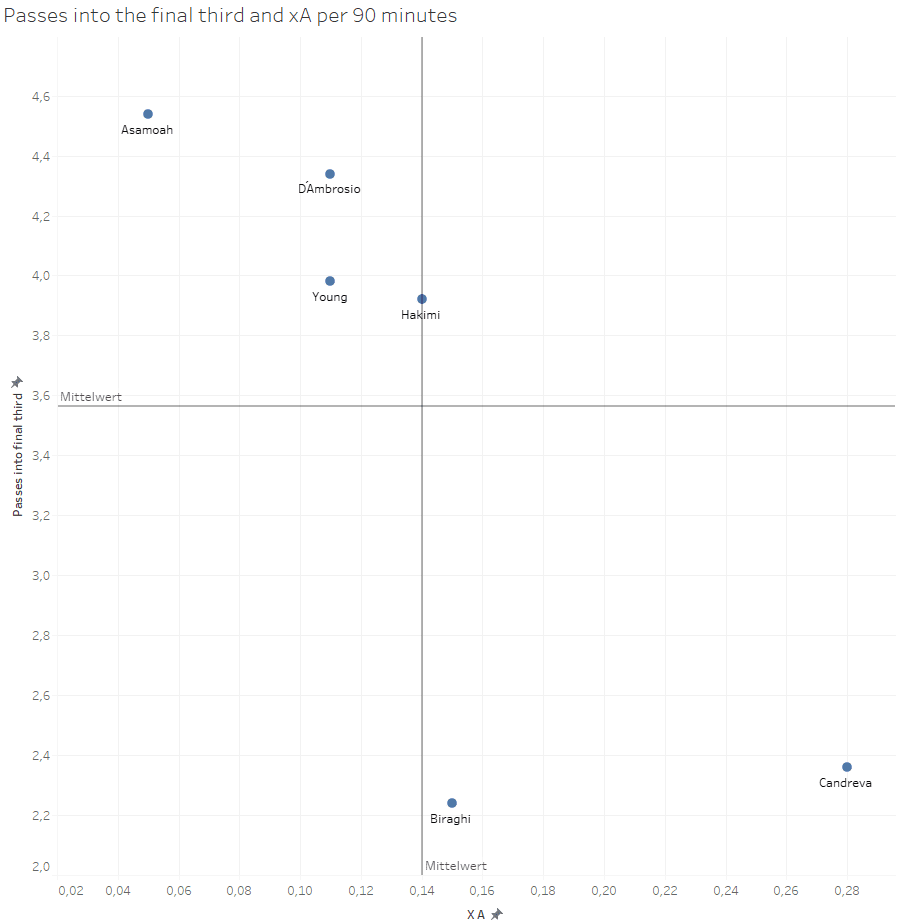
Playmaking
In case, Conte still wants to play through the centre, this will be no problem for Hakimi as he assisted several goals from these kinds of area as well. Not only his crosses are dangerous but so are his interface passes too.
In the image below, Hakimi received the ball out wide but this time, he started to drift into the centre as Brandt moved out wide. Thanks to his overview, he is able to play a perfect-timed interface pass to Sancho who can score easily from within the opponent´s box.

In the next situation, Dortmund is in a quick transition and Hakimi reacts quickly to play a through ball to Sancho who is starting a run in behind the defensive line.

In fact, Hakimi played the fifth-most passes as a wing-back/full-back (67.58 per 90 minutes). Quite good 84,34% of these passes were successful. This is an ability which will be very important to create goal-scoring opportunities after counter-attacking situations at Inter.

In the comparison below, it is outstanding that Hakimi makes the most successful pressures (4,83 per 90 minutes) and afterwards, he can use his good passing ability to contribute successful passes during the transition. Only Asamoah (85,4%) has a higher passing completion rate than Hakimi (84,34%). However, Hakimi seems to be a perfect player for high pressing and transitions.
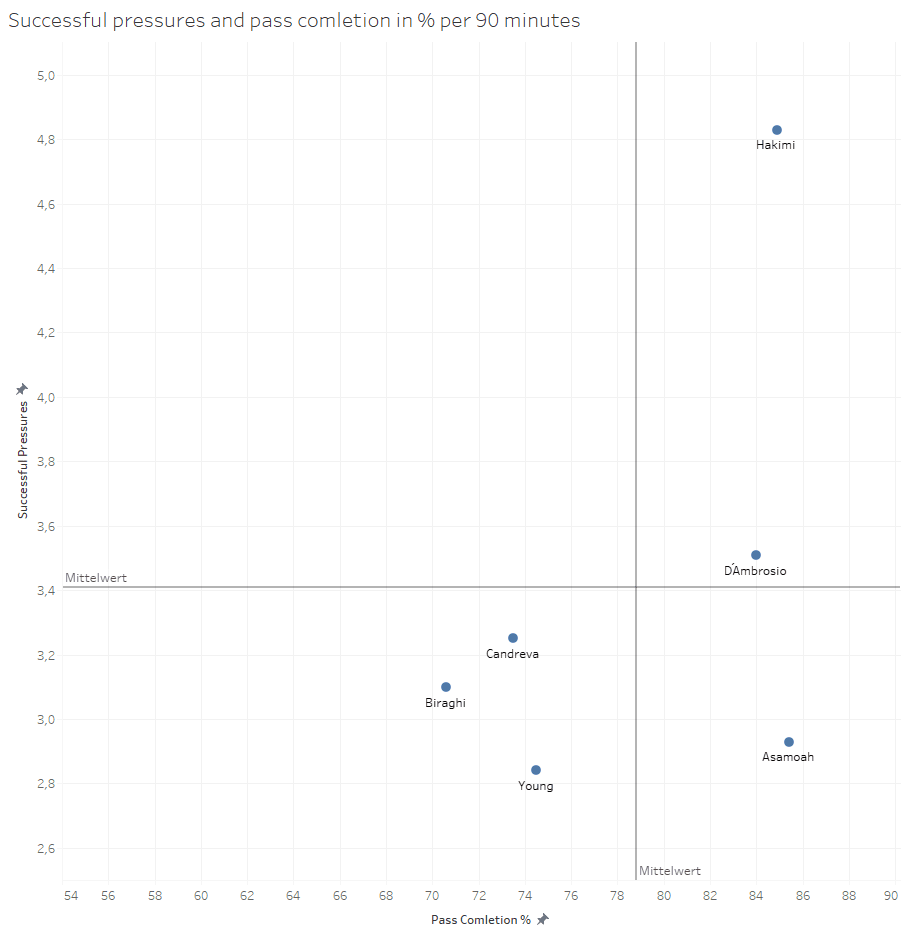
Defensive contribution
Hakimi´s offensive playing style is fascinating. However, as a wing-back, he is responsible for defensive work as well. Because of his offensive playing philosophy, he often struggles to get back into the backline. It is obvious that his position requires an intense work rate and therefore, Hakimi needs to run up and down the wing very often. This also means that Hakimi will have to improve his stamina as his defensive contribution is his biggest weakness.
As already mentioned, Inter is well-known for their defensive stability and they concede only a few goals because of the discipline of their defenders. In defensive transitions, Conte´s intensive play philosophy also demands his players to get behind the ball as fast as possible. In the image below, we can see Inter in a defensive transition trying to get all players behind the ball to intercept Juventus´ attack. All five defenders are behind the ball and together with the central midfielders, they build a compact shape with numerical superiority.

In the next image, we take a closer look at a defensive transition of Dortmund. They only have three defenders against four strikers and Hakimi should be in a more defensive position on the pitch. This would help him preventing a goal-scoring opportunity by marking his opponent. However, in this situation, his opponent has to much space to receive a possible pass.

In the following image, Dortmund faces a counter-attack again. And again, the distance between Hakimi and his next opponent is too large. If Düsseldorf´s forward plays a through pass between Mats Hummels and Łukasz Piszczek to his teammate, Hakimi will not be able to go into a tackle against his opponent.

Even if systems with a back-three/back-five always involves the risk of wing-backs coming back too late, Conte got his team to be disciplined enough to be behind the ball very quickly. Not only the defensive line, but also the midfielders and forwards work back intensively as you can see in the match against Barcelona:
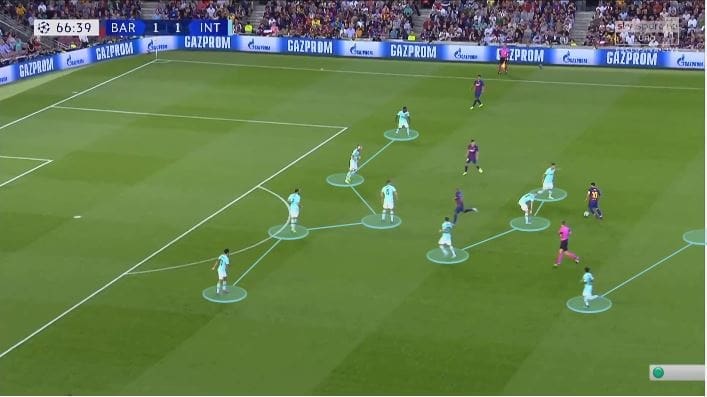
Compared to Inter´s wing-backs, Hakimi is dispossessed too many times during a game (1,85). This can lead to goal-scoring opportunities for the opponents very quickly. No Inter wing-back is more often dispossessed than 0,9 times per 90 minutes. Nevertheless, thanks to his pace and intelligence he is able to win lots of tackles (1,65 per 90 minutes). Only Danilo D`Ambrosio wins more tackles (1,73 per 90 minutes). This shows that Hakimi could be very important in the defensive shape even if he might be dispossessed sometimes.
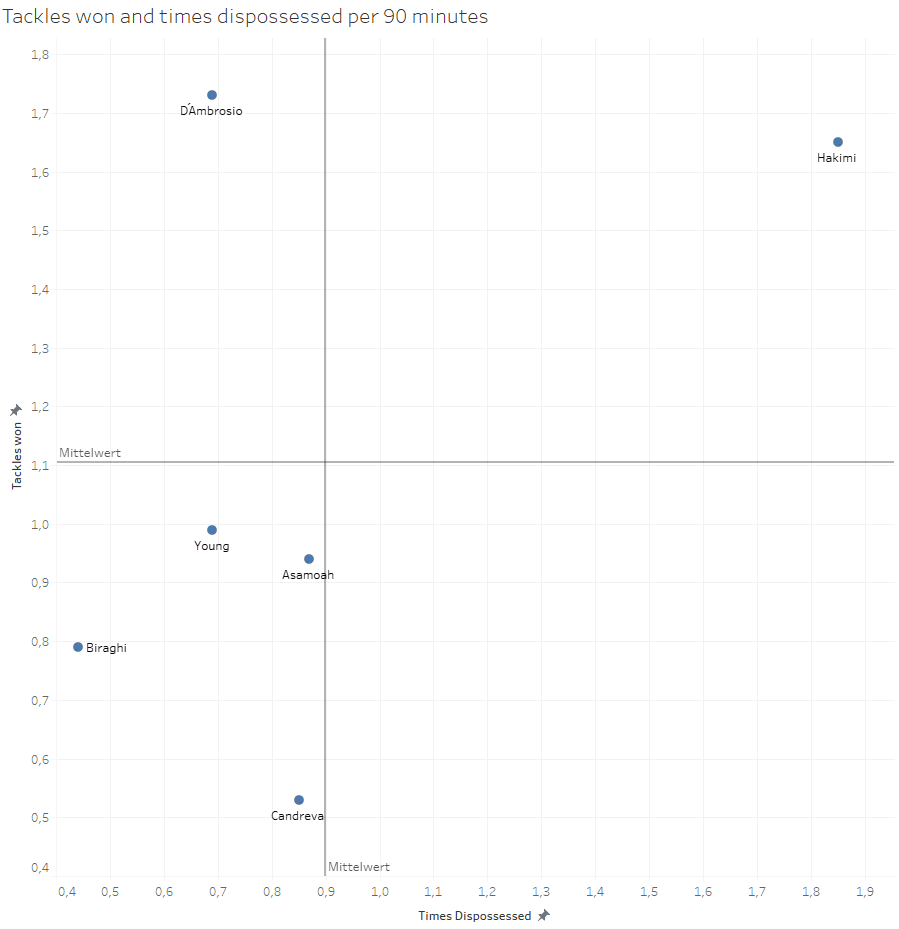
Even his quickness obviously helps Hakimi in this regard as it allows for recovery, he still lacks positional awareness. That is why this is an ability, Hakimi will have to improve during next season. He is known to get caught out by wingers both directly defending the ball and while off it. Hakimi’s next step in development is concentration and defensive awareness in his own half. This might be the reason why Real Madrid did not want Hakimi to stay as they play with a back-four where these kinds of mistake are even worse.
Conclusion
The Moroccan improved a lot at his loan spell in Dortmund and developed himself into maybe the best wing-back in the world, especially due to his offensive threat. All in all, this is a tremendous move for both sides. Hakimi gets coach renown for having well-drilled defensive sides which will improve his game. Conte also gets a dynamic offensive weapon that is perfect for the system he plays. As shown in this analysis, with Hakimi in the squad, Inter is one step further in the title race and could challenge Juventus even more next season.





Comments